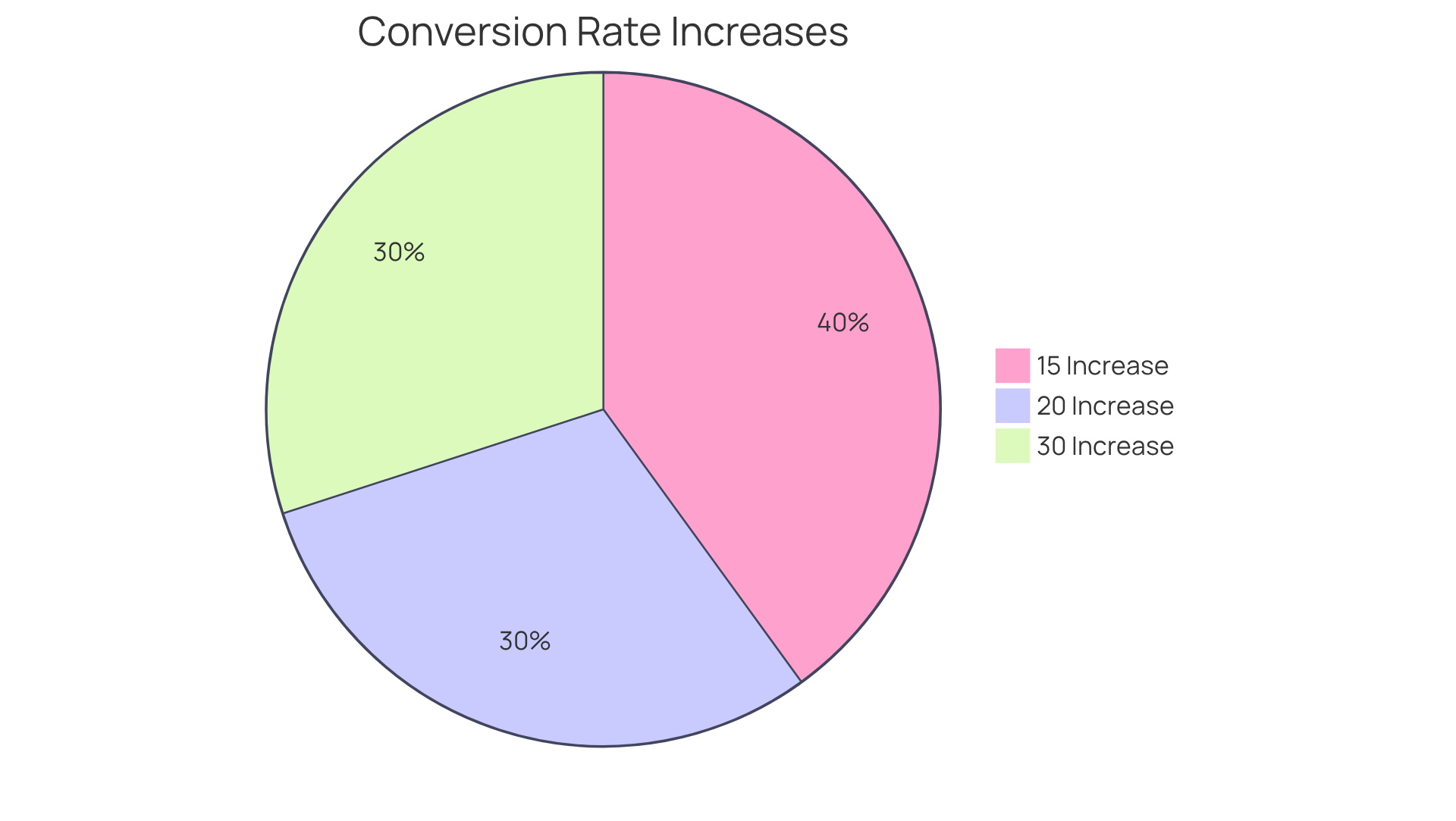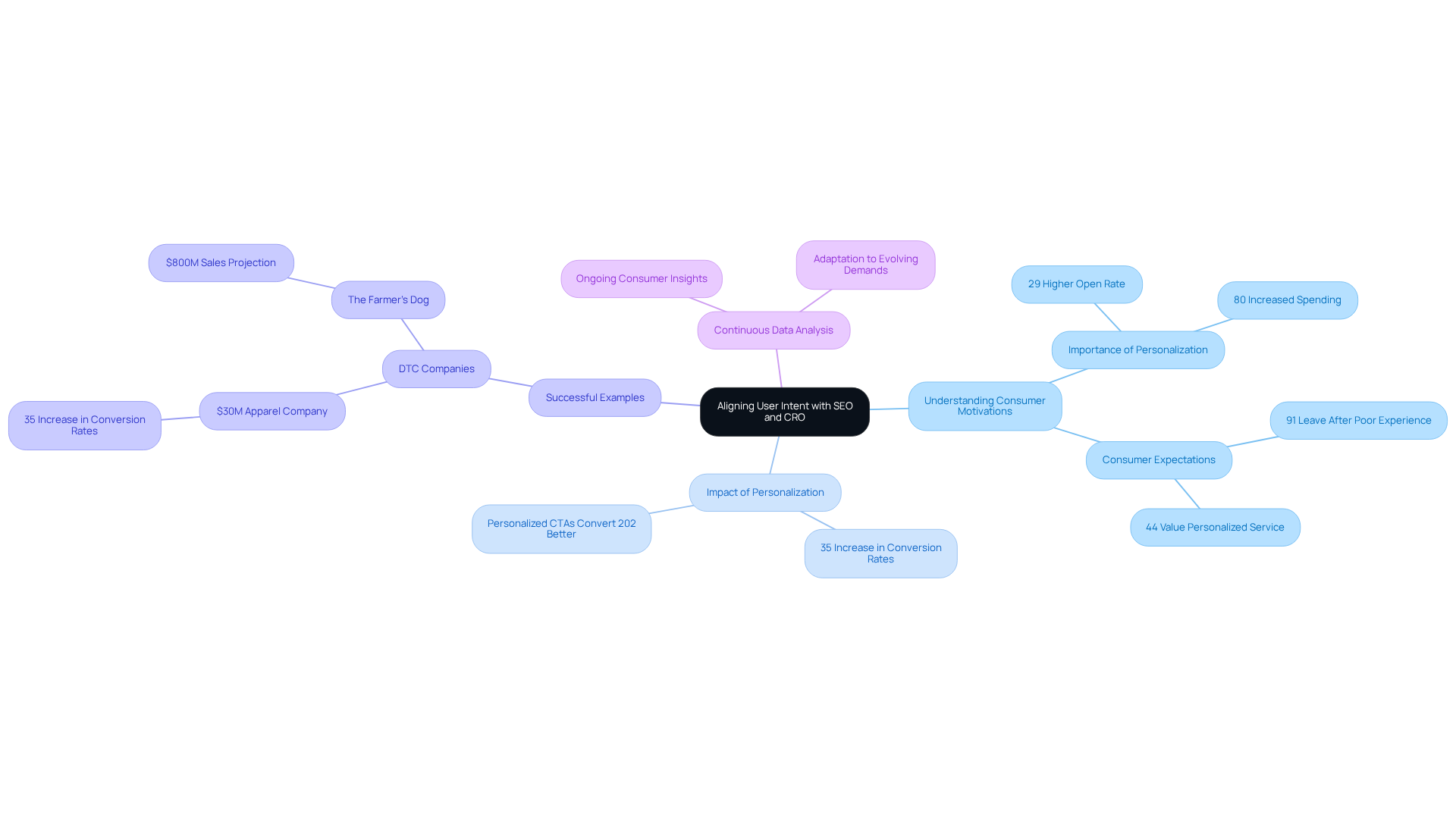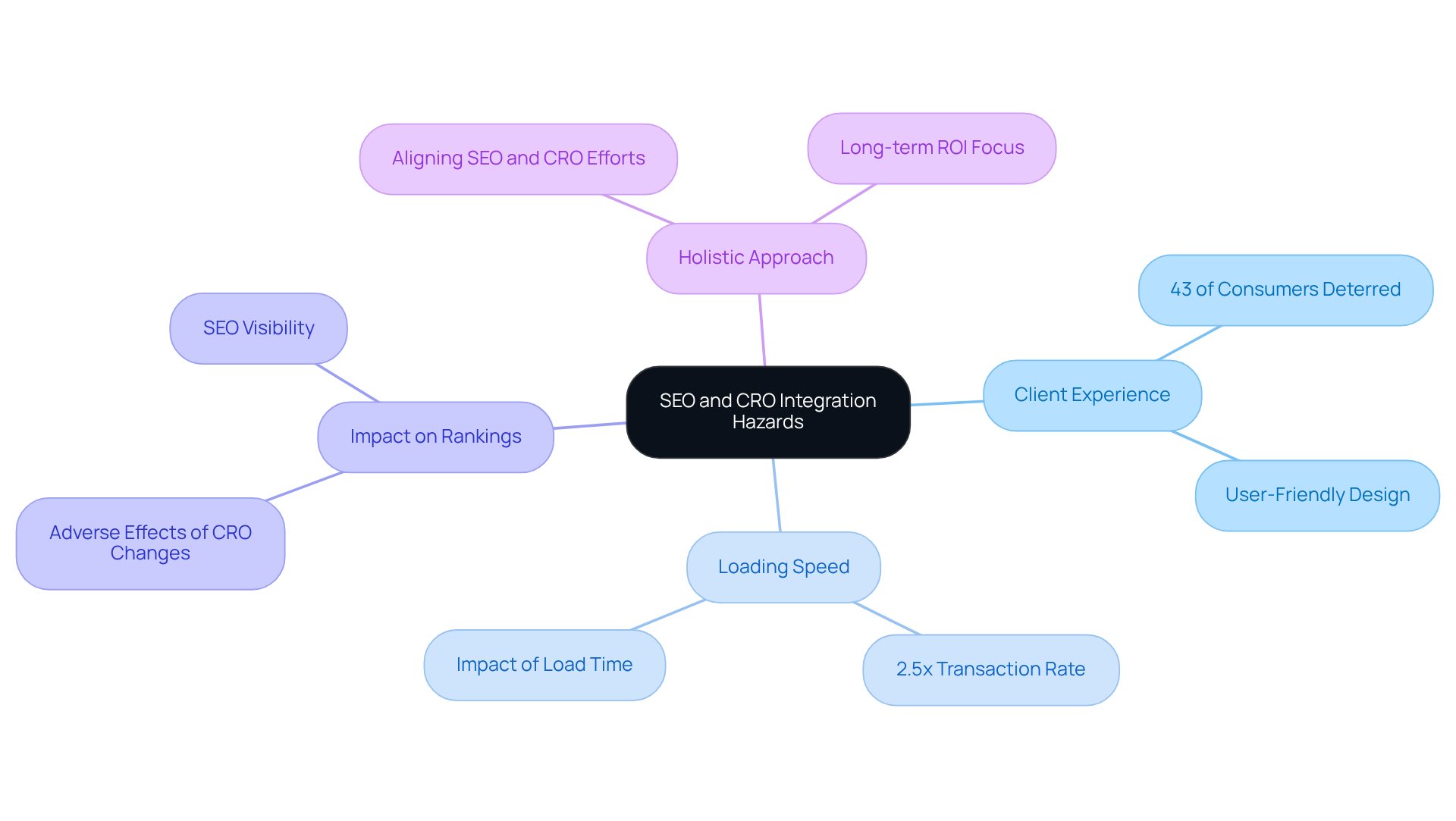
Overview
This article delves into the crucial SEO and Conversion Rate Optimization (CRO) strategies that can significantly propel growth for Direct-to-Consumer (DTC) brands. A data-driven approach is not just beneficial; it’s essential. By prioritizing user experience and aligning SEO with CRO efforts, brands can enhance both visibility and conversion rates.
Consider this: expert insights and compelling statistics underscore the effectiveness of these strategies. For instance, brands that integrate SEO and CRO see a marked improvement in their online performance. This synergy not only boosts traffic but also converts visitors into loyal customers.
To truly grasp the potential of these strategies, one must recognize the importance of actionable insights. By implementing these techniques, DTC brands can navigate the competitive landscape with confidence. The path to growth is clear, and the tools are at your disposal.
In summary, embracing a comprehensive approach to SEO and CRO is not merely an option; it’s a necessity for DTC brands aiming for sustained success. The data speaks volumes, and the time to act is now.
Introduction
Crafting a successful Direct-to-Consumer (DTC) brand demands more than just a great product; it requires the strategic integration of Search Engine Optimization (SEO) and Conversion Rate Optimization (CRO). In an increasingly competitive digital landscape, understanding how these two elements work together can create substantial growth opportunities. Yet, many brands find it challenging to align their SEO and CRO efforts, resulting in missed chances for engagement and sales.
What essential strategies can bridge this gap and propel DTC brands toward sustained success? By focusing on the synergy between SEO and CRO, brands can enhance their visibility and conversion rates, ultimately driving revenue. This article will explore actionable insights that not only highlight the importance of these strategies but also provide a roadmap for implementation.
Parah Group: Tailored CRO Strategies for SEO Integration
Parah Group employs a data-driven approach to craft tailored plans for SEO and CRO that seamlessly align with their strategies. By meticulously analyzing user behavior and traffic patterns, they pinpoint critical areas for enhancement. This not only elevates conversion rates but also amplifies organic search visibility with effective SEO and CRO strategies.
Such a comprehensive strategy ensures that every improvement effort contributes to immediate sales goals while fostering sustainable company growth. For Direct-to-Consumer (DTC) companies, adopting these techniques is not just beneficial; it’s essential for achieving lasting success in a competitive landscape.
Incorporating data and expert insights, Parah Group’s methodology stands as a testament to the power of informed decision-making in driving business outcomes. Embrace this approach to secure your position in the market and thrive.

SEMrush: Tools for Aligning SEO and CRO Efforts
SEMrush provides a robust suite of tools that expertly integrates SEO CRO strategies tailored for direct-to-consumer enterprises. With essential features like keyword tracking, site audits, and competitive analysis, companies can gain invaluable insights that elevate their marketing efforts. By leveraging these tools, brands can identify high-performing keywords that not only drive traffic but also convert visitors into loyal customers. This dual focus guarantees that both SEO and SEO CRO objectives are efficiently met.
Digital marketing specialists emphasize the critical role of keyword monitoring in boosting success rates. Aligning content with audience intent—whether it’s informational or transactional—can significantly enhance engagement and drive results. DTC companies that have effectively implemented keyword tracking and conducted comprehensive site audits report remarkable improvements in their SEO CRO metrics. These strategies empower companies to refine their messaging and enhance user experience, ultimately leading to increased sales and customer loyalty.
Furthermore, SEMrush's tools support continuous optimization, allowing companies to adapt to evolving market dynamics and consumer behavior. By consistently monitoring performance and adjusting strategies based on data-driven insights, DTC companies can maintain a competitive edge and foster sustainable growth. The importance of audience engagement as a key SEO ranking factor underscores the necessity of these strategies, as heightened engagement often correlates with improved conversion rates. Parah Group's approach consistently demonstrates that effective CRO not only boosts profitability but also ensures the long-term success of the company.

Shopify: Enhancing User Experience through SEO and CRO
Shopify empowers DTC companies to dramatically enhance customer experience by expertly integrating SEO and CRO strategies. By optimizing product pages with relevant keywords and compelling calls-to-action, businesses can improve their SEO and CRO while boosting search engine rankings and guiding customers through a seamless purchasing journey. This dual focus elevates visibility and significantly increases success rates.
Recent data reveals that companies employing these strategies can see conversion rates soar by 15-30%. This statistic underscores the critical need for businesses to prioritize user experience in their digital strategies, especially with the implementation of SEO and CRO. Experts assert that a well-organized product page, featuring clear messaging and persuasive calls-to-action, is essential for converting visitors into customers. Therefore, it is imperative for DTC companies to continuously refine their approach.

Neil Patel: Keyword Selection for Effective SEO and CRO
Neil Patel underscores the critical role of keyword selection in shaping effective SEO CRO strategies. By focusing on long-tail keywords that resonate with user intent, DTC companies can improve their seo cro and draw in more qualified traffic. This targeted approach not only boosts search engine rankings but also significantly enhances engagement potential. Visitors are more inclined to interact with content that meets their specific needs and interests.
For instance, companies that have adopted long-tail keywords have reported notable increases in engagement rates and improved performance metrics, highlighting the tangible benefits of this strategy. As user behavior shifts—especially with the growing prevalence of voice search and conversational queries—aligning content with long-tail keywords becomes increasingly vital for improving seo cro and capturing the attention of visitors ready to convert.
In conclusion, prioritizing long-tail keywords is not just a trend; it’s an essential strategy for DTC companies aiming to thrive in a competitive landscape. By understanding and implementing this approach, businesses can ensure they attract and engage the right audience effectively.

Convert.com: Unifying Goals for SEO and CRO Success
Convert.com firmly advocates for the unification of SEO and SEO CRO goals, a strategy essential for achieving comprehensive marketing success. By establishing common objectives, DTC brands can ensure that their SEO CRO initiatives effectively bolster their sales strategies. This strategic alignment not only streamlines marketing processes but also significantly enhances overall performance. As both teams work towards shared goals, they simultaneously boost traffic and drive results, creating a powerful synergy that propels business growth.

WebFX: Content Optimization for SEO and Conversion Rates
Parah Group underscores the critical role of content optimization in enhancing both SEO and CRO, as well as overall sales performance. By crafting high-quality content that is both SEO-friendly and focused on SEO CRO, DTC companies can significantly improve their search visibility and foster user engagement. This dual focus on content quality and relevance not only attracts more visitors but also increases the likelihood of achieving business objectives, making it an indispensable strategy for growth.
To maximize profitability, Parah Group adopts a holistic approach to SEO CRO, implementing a comprehensive five-step process that integrates consumer psychology. Their data-driven strategies ensure that every piece of content is meticulously optimized for search engines, with a strong emphasis on SEO CRO to target desired outcomes. This approach ultimately cultivates sustainable growth for DTC companies, reinforcing the importance of strategic content development in today’s competitive landscape.

NoGood.io: A/B Testing for SEO and CRO Alignment
A/B testing serves as a cornerstone for DTC companies aiming to elevate their sales rates and improve their SEO CRO strategies. By systematically testing various web page components, brands can pinpoint which features resonate most with consumers and drive purchases. This iterative approach not only enriches user experience but also guarantees that marketing efforts are consistently refined for peak performance.
Consider the impact of personalized calls to action (CTAs); they have been shown to be 202% more effective than their generic counterparts. This statistic underscores the significant role customized content plays in boosting success rates. Furthermore, a staggering 77% of companies engage in A/B testing on their websites, with nearly 80% reporting improved outcomes from these initiatives. Notably, Dell achieved over a 300% increase in success rates through A/B testing, illustrating the potential for remarkable enhancements.
Parah Group's comprehensive strategies for SEO CRO highlight the importance of rigorous testing and a holistic approach, ensuring that paid ads and landing pages are perfectly aligned to foster substantial growth. To implement A/B testing effectively, DTC companies should start by evaluating one element at a time. This method allows for precise assessment of its impact on success rates, as evidenced by successful case studies that showcase the efficiency of this targeted approach.

Session Interactive: Creating Seamless Customer Journeys
Session Interactive underscores the critical role of creating seamless customer journeys to boost both SEO, CRO, and sales outcomes. By meticulously mapping the customer experience, DTC companies can pinpoint friction points that hinder the purchasing process. This strategic emphasis on user experience not only elevates search engine rankings but also significantly enhances SEO, CRO.
For instance, companies that streamline their customer journeys witness a notable increase in finalized purchases. A more seamless, intuitive experience driven by SEO, CRO encourages customers to complete their transactions. The integration of journey mapping tools, such as TheyDo's Journey AI, empowers companies to visualize interactions and identify areas for improvement, ensuring that every touchpoint positively impacts the overall customer experience.
Successful companies like Starbucks exemplify this approach; by refining their mobile ordering system, they minimized friction, resulting in substantial increases in conversion rates, ultimately driving growth and profitability. DTC companies must regularly update their customer journey maps to reflect evolving consumer behaviors, ensuring their strategies remain relevant and effective.

Transistor Digital: Aligning User Intent with SEO and CRO
Transistor Digital underscores the critical need to align audience intent with SEO CRO strategies. Understanding consumer motivations and search behaviors allows DTC companies to effectively tailor their content and engagement strategies for SEO CRO. This alignment not only boosts search visibility but also significantly increases engagement rates, as individuals are more likely to interact with content that aligns with SEO CRO by meeting their needs and expectations.
For instance, companies that personalize their content based on consumer insights have reported a remarkable 29% higher open rate and a 41% greater click-through rate compared to their non-personalized counterparts. Successful DTC companies, such as those partnering with Parah Group, demonstrate that grasping user motivations leads to improved sales outcomes. A $30M apparel company, for example, saw a 35% increase in conversion rates after implementing strategies like homepage redesigns that highlighted social proof and optimized product pricing.
Moreover, 44% of customers tend to return to businesses that offer personalized service, and 80% of companies report increased consumer spending when experiences are tailored to individual preferences. By prioritizing consumer intent, companies can improve their SEO CRO efforts to craft engaging narratives that foster deeper connections with their audience. To further enhance these strategies, DTC companies should continuously analyze consumer data and adapt their content to meet evolving customer demands.

Conversion.com: Navigating the Hazards of SEO and CRO Integration
Conversion.com underscores the critical hazards that DTC brands face when integrating SEO CRO strategies. A prevalent mistake is neglecting client experience in the quest for SEO optimization, which can lead to diminished success rates. Consider this: slow-loading mobile sites deter 43% of consumers from returning, underscoring the necessity for a seamless user experience. Furthermore, B2C websites with a one-second load time see a 2.5 times higher transaction rate compared to those with a five-second load time, emphasizing the vital role of speed in customer satisfaction.
Implementing CRO changes that adversely affect search rankings can undermine overall marketing effectiveness. Notably, 55% of purchase-related outcomes occur within an hour of a mobile search, highlighting the importance of optimizing both SEO and SEO CRO strategies. To mitigate these risks, companies must adopt a holistic approach that aligns their SEO CRO efforts. This ensures that enhancements in user experience not only elevate conversion rates but also bolster search visibility.
By leveraging comprehensive CRO strategies, as advocated by Parah Group, which include rigorous testing and a focus on long-term ROI, DTC brands can maximize profitability. This approach fosters sustainable marketing initiatives that drive growth and profitability.

Conclusion
DTC brands aiming to excel in a competitive marketplace must prioritize the integration of SEO and CRO strategies. This alignment not only enhances visibility in search engines but also significantly boosts conversion rates, driving sales growth. By adopting a comprehensive, data-driven approach, brands can ensure their marketing efforts are effective and sustainable in the long run.
Key strategies include:
- Tailored CRO techniques
- Effective keyword selection
- A strong emphasis on user experience
Tools like SEMrush and platforms such as Shopify are pivotal in enabling DTC companies to refine their approaches. Additionally, A/B testing and customer journey mapping are essential for identifying and eliminating friction points. By focusing on these elements, brands can create a seamless experience that resonates with consumers, leading to improved engagement and loyalty.
In conclusion, the successful integration of SEO and CRO is crucial for DTC brands pursuing growth and sustainability. By continuously analyzing data and adapting strategies to meet evolving consumer needs, businesses can position themselves for long-term success. Embracing these essential strategies not only fosters immediate results but also lays the groundwork for future opportunities in an ever-changing digital landscape.
Frequently Asked Questions
What is the main focus of Parah Group's strategies?
Parah Group focuses on crafting tailored plans for SEO and CRO that align with their strategies through a data-driven approach, analyzing user behavior and traffic patterns to enhance conversion rates and organic search visibility.
Why is it essential for Direct-to-Consumer (DTC) companies to adopt SEO and CRO techniques?
For DTC companies, adopting SEO and CRO techniques is essential for achieving lasting success in a competitive landscape, as it contributes to immediate sales goals and sustainable company growth.
How does SEMrush support the alignment of SEO and CRO efforts?
SEMrush provides a suite of tools, including keyword tracking, site audits, and competitive analysis, that help DTC companies gain insights to elevate their marketing efforts and ensure both SEO and CRO objectives are met.
What role does keyword monitoring play in digital marketing success?
Keyword monitoring is critical in boosting success rates by aligning content with audience intent, which enhances engagement and drives results for DTC companies.
What improvements can DTC companies expect from implementing keyword tracking and site audits?
Companies that implement keyword tracking and conduct comprehensive site audits report significant improvements in their SEO and CRO metrics, leading to refined messaging and enhanced user experience.
How does Shopify enhance user experience for DTC companies?
Shopify enhances user experience by integrating SEO and CRO strategies, optimizing product pages with relevant keywords and compelling calls-to-action to improve search engine rankings and guide customers through a seamless purchasing journey.
What impact can effective SEO and CRO strategies have on conversion rates?
Companies employing effective SEO and CRO strategies can see conversion rates increase by 15-30%, highlighting the importance of prioritizing user experience in digital strategies.
What is the importance of a well-organized product page for DTC companies?
A well-organized product page with clear messaging and persuasive calls-to-action is essential for converting visitors into customers, making continuous refinement of this approach imperative for DTC companies.
FAQs











